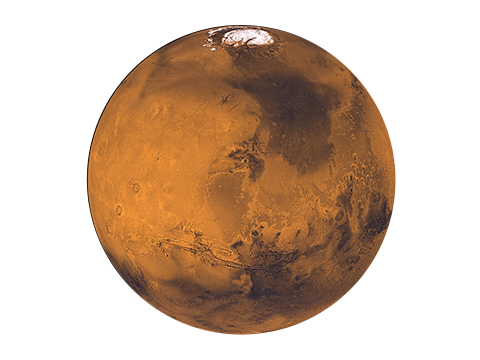Mars Facts
Planet Profile
| Type | Terrestrial |
| Age | 4.603 billion years |
| Length of Year | 1.88082 Earth year |
| Satellites | 2 |
| Diameter | 4,212 mi |
| Mass | 6.4171×1023 kg |
| Volume | 1.6318×1011 km3 |
| Orbit Speed | 24.007 km/s, ave |
| Dist. from Sun | xxx million km, ave |
Below are some of the facts about Mars:
- Mars is the fourth planet in the solar system, and comes right after Earth. It is also the second smallest in size, and popularly called the red planet for its red color.
- Mars has two moons, Phobos and Deimos. There moons are small and irregularly shaped.
- Mars is only 15% of the Earth’s volume and 10% of the Earth’s mass.
- Gravity on surface of Mars is 37% that of Earth.
- The landmass of Earth and Mars are almost equal. As Earth’s greater surface is covered by oceans and water bodies, hence the collective land mass of earth equals that of mars.
- Mars has the largest mountain and volcano in the solar system. It’s called the Olympus Mons. This volcano is 600 km in diameter, 21 km in height, a very old formation, and is believed to be still active because of evidence of lava flowing out of it in recent years.
- There have been many missions to mars. The 40th mission was done in 2014. Landers, orbiters, rovers all were sent to the planet, but only 18 were deemed successful.
- Successful missions to Mars were completed by Curiosity in 2012, MAVEN on September 2014, ISRO’s MOM Mangalyaan in September 2014, and another upcoming mission is the NASA’s Insight, expected to be completed in a year or two.
- The orbit of Mars around the sun is more elliptical and elongated than all other orbits of the other planets. Hence Mars experiences extreme weather conditions. The climate is extreme and the fiercest dust storms occur whhen the planet is closest to the sun. These dust storms can vary from a storm over a small area, to gigantic storms that cover the entire planet.
- The sun appears smaller and almost half the size than it looks like from earth.
- When Mars is at the closest to the sun while rotating in orbit, then the southern hemisphere of Mars is inclined towards the sun and this brings very hot summers which are short, and at that time the southern hemisphere gets a short cold winter. When at the farthest point from the sun, the summers turn mild and long, and the winters turn cold and long.
- Many tiny and small parts of mars got ejected out of the planet as meteorites, which traveled in the solar system for some time, and some of them crashed on to the surface of Earth.
- Scientists found clue about Mars land and atmosphere through its meteorites that hits the Earth. This knowledge help in planning mission to the red planet.
- Signs of water existence on Mars were found as stains or marks of trickling water down the craters in some volcano. Also it’s believed that water existed there at a time in the form of ice.
